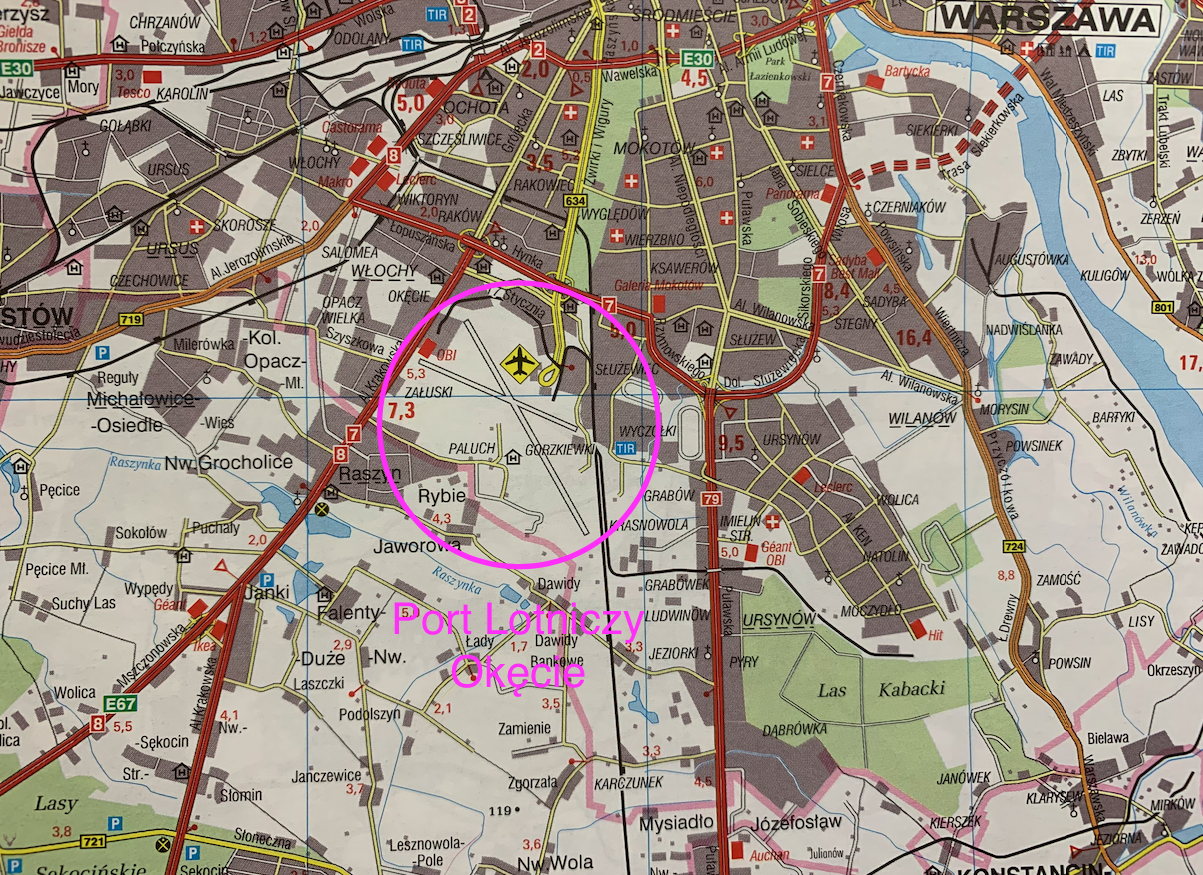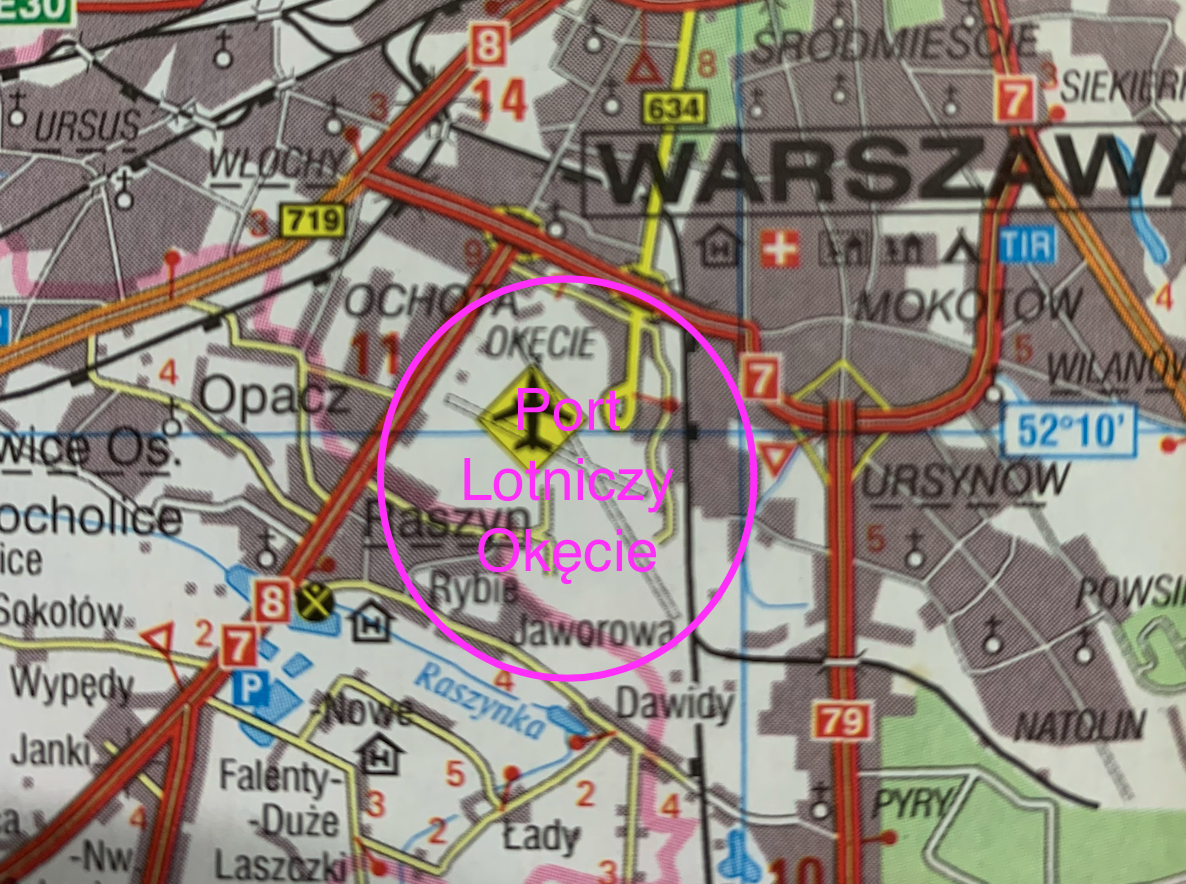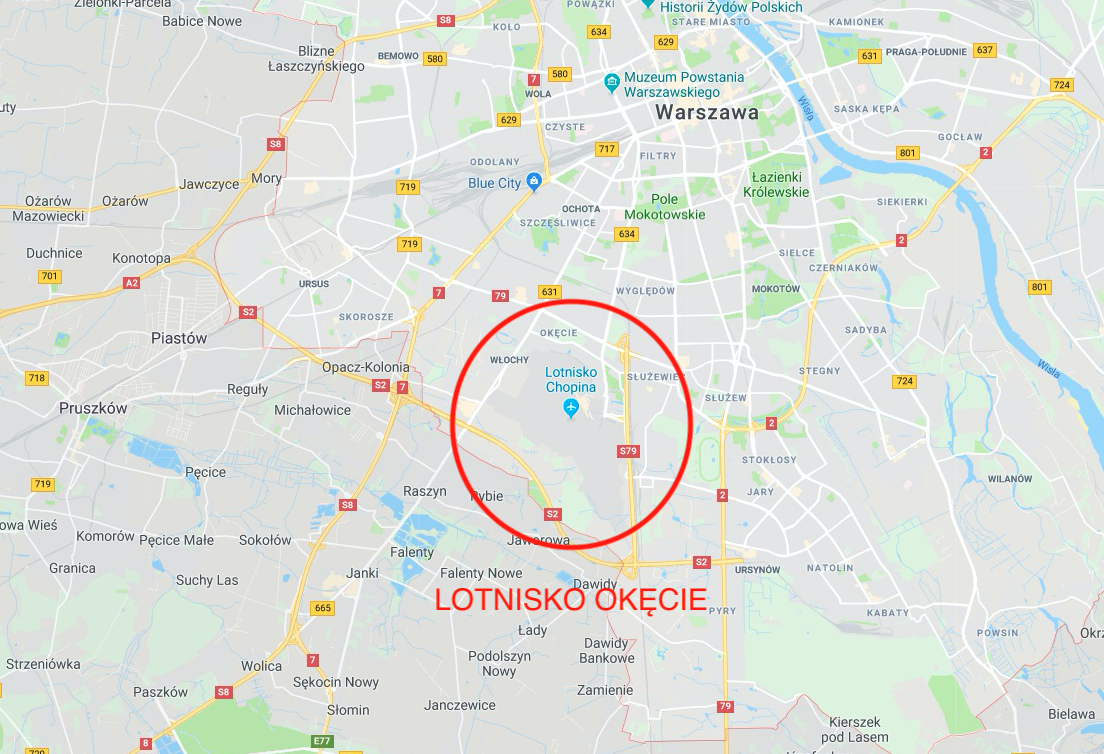Warszawa 2009-12-03
Lotnisko Okęcie w Warszawie.
Historia osady Okęcie.
Obecnie (2009 rok) dzielnica Warszawy zwana Okęciem kojarzy się z lotniskiem. Ale historia Okęcia sięga czasów średniowiecznych, kiedy powstała tu osada należąca do parafii Służew. Zamieszkiwała ją szlachta herbu Wierzbowa i Prus. Następnie na długi czas stała się własność rodu Okęckich. Stąd późniejsza nazwa. Jej powierzchnia wynosiła około 2 łany większe. (1 łan większy = 48 mórg = 24,2 hektary). Następnie własność przechodziła przez kolejne rody. W XVII wieku, należała do Petrykowskiego, a w XVIII wieku do generała Byszewskiego, który ponadto posiadał sąsiednie Załuski, Opacz i część Rakowa. Przez dzisiejsze Okęcie przebiegał Trakt Radomski, który w czasie najazdów szwedzkich uległ zniszczeniu. Do odbudowy jego przystąpiono po 1720 roku. W 1789 roku. Okęcie liczyło 26 gospodarstw. W XIX wieku, powstał wielki majątek ziemski obejmujący Okęcie, Raków i Marcinkówkę. Właścicielami tego majątku była rodzina Łabędzkich. Zabudowania folwarku mieściły się przy obecnej ulicy 17 Stycznia. Właściciele w 1856 roku, zbudowali pałacyk według projektu Bolesława Orłowskiego. Administracyjnie, w tym okresie, tereny te należały do gminy Pruszków. W tym czasie wybudowano Trakt Krakowski i forty obronne.
W maju 1789 roku, pierwszy Polak wzniósł się w powietrze nad Warszawą. Lot balonem na ogrzane powietrze wykonał Jan Nepomucen Potocki. Lot trwał jedną godzinę.
Pierwsze warszawskie lądowisko to tor wyścigów konnych przy ulicy Polnej, z czasem przekształcony w Lotnisko Mokotowskie. Teren wyścigów konnych zwany był za czasów okupacji carskiej, urzędowo – Miesto dla konnoj skaczki. Znajdował się on po zachodniej stronie dzisiejszej ulicy Polnej. I tam to w 1909 roku, warszawiacy obejrzeli pierwszy samolot. W dniu 17 września 1909 roku, francuz pan Legagneux wykonał około 2 minutowy, pierwszy silnikowy lot.
Rok później powstało Koło Awiatorów korzystające z Terenów Wyścigów. Potem wzloty odbywały się także z trawników biegnących tam, gdzie dziś przebiega Trasa Łazienkowska.
W dniu 13 sierpnia 1911 roku, pierwszy lot samolotem na Stolicą wykonał Michał Scipio del Campo, Polak o włoskim nazwisku. Lot trwał około 17 minut i przebiegał wzdłuż ulicy Polnej, następnie Marszałkowskiej, nad Placem Zamkowym zawrócił i tą samą trasą powrócił do miejsca startu. Następnego dnia, czyli 14 sierpnia 1911 roku, drugi Polak pan Jankowski wykonał lot swoim samolotem wznosząc się na wysokość 1 200 m, czyli dwa razy wyżej niż Michał Scipio del Campo. Lot był planowany na 13 sierpnia 1911 roku, ale zawiódł wówczas silnik. Loty Polaków żywo opisywała prasa codzienna. Dziennikarze używali określeń; „okrążył lotnisko, wzbił się nad lotniskiem”. W ten sposób prasa uznała, że tereny Wyścigów Konnych stały się lotniskiem. Od 1912 roku lotów wykonywano coraz więcej, a obszar lądowiska na Polach powiększał się.
Kolejny etap rozwoju lotniska na Polu Mokotowskim nastąpił podczas wojny światowej. Od 1915 roku, teren ten dostał się pod okupację niemiecką.
Lotnisko Okęcie.
Największe zmiany dla Okęcia nastąpiły po odzyskaniu przez Rzeczpospolitą Polską niepodległości w 1918 roku, kiedy to Okęcie uwzględniono w planie przestrzennym miasta Warszawy. Tereny te wówczas podlegały Gminie Skorosze. Co ciekawe, już wtedy zdawano sobie sprawę, że Lotnisko Mokotów będzie hamował rozwój Warszawy w kierunku południowym i rajcy odpowiedzialni za miasto planowali w przyszłości trzy lotniska – wojskowe na Okęciu, sportowe na Bielanach (w rejonie obecnego Wrzeciona) oraz wielkie pasażerskie na Gocławiu. Natomiast po II wojnie światowej zbudowano ogromne lotnisko wojskowe na dzisiejszym Bemowie/Bernerowie.
Do początku lat 30, Lotnisko Mokotowskie działało w najlepsze i mimo późniejszych przenosin na Okęcie wciąż lądowały tam samoloty. Ciekawostką jest to, że jeszcze do 1947 roku, lądowały tu samoloty, głównie wojskowe.
W 1923 roku, do Okęcia doprowadzono kolej i linię tramwajową. Lotnisko na Okęciu zaczęło budować w 1924 roku. Na cel nowego lotniska wykupiono teren o powierzchni 456 hektarów. W 1929 roku powstała tu Wytwórnia Silników PZL i Warsztaty Remontowe Samolotów Cywilnych. W 1929 roku na Lotnisko Okęcie przeniesiono kilka eskadr bojowych.
W okresie 1933-1934 dokonano przeniesienia ruchu lotniczego z Lotniska Pole Mokotowskie na Okęcie. Zbudowano wówczas do lotniska Okęcie drogę od Śródmieścia. To dzisiejsza Al. Żwirki i Wigury.
Od 1933 roku tereny Okęcia stały się ośrodkiem przemysłu związanego z lotnictwem, gdzie pracowało, w 30-tych latach XX wieku, ponad 7 500 osób. Trzeba pamiętać, że nadal dzielnica Okęcie była terenem rolniczym, która dostarczała żywność dla miasta.
W dniu 29 kwietnia 1934 roku, na Lotnisku Okęcie uroczyście otwarto dworzec lotniczy. Był Prezydent Ignacy Mościcki, Premier Janusz Jędrzejewski, marszałek Sejmu, pięciu ministrów, korpus dyplomatyczny z ambasadorami Stanów Zjednoczonych, CCCP, Włoch, dyrektorzy siedmiu europejskich linii lotniczych. Mszę Świętą odprawił biskup polowy ksiądz Józef Gawlina.
Uroczyste otwarcie Lotniska Okęcie. Msza Święta Polowa celebrowana przez księdza biskupa polowego Józefa Gawlina. Na honorowym miejscu Prezydent Ignacy Mościcki. 29 kwiecień 1934 rok. W pierwszym rzędzie z lewej strony siedzieli od prawej: premier Janusz Jędrzejewicz, marszałek sejmu Kazimierz Świtalski, wojewoda warszawski Stanisław Twardo, minister spraw wewnętrznych Bronisław Pieracki, wojewoda warszawski Władysław Jaroszewicz, minister skarbu Władysław Marian Zawadzki, minister pracy i opieki społecznej Stefan Hubicki, minister komunikacji Michał Butkiewicz, minister poczt i telegrafów Emil Kaliński, wiceminister spraw zagranicznych Jan Szembek. Z prawej strony siedzieli przedstawiciele dyplomacji.
Dworzec lotniczy Lotniska Okęcie był nowoczesny. Pomiędzy hangarami były dwa stylowe budynki. W jednym był dworzec w drugim obsługa lotniska.
Ponad terenem wznosiła się 50-metrowa wieża z latarnią lotniskową, widoczną w promieniu 100 kilometrów. Tak bowiem rozwiązywano wtedy problemy nawigacyjne. Dzięki tej latarni piloci mieli ułatwioną orientację. Funkcjonowała ona na identycznej zasadzie jak latarnie morskie. W tym czasie nie było jeszcze stacji radiolokacyjnych.
Od otwarcia Lotniska Okęcie, rozwój nastąpił bardzo szybko. W 1935 roku lotnisko Okęcie obsłużyło około 11 000 pasażerów. Pojawiały się nowoczesne samoloty; Douglas DC-2, Lockheed L-14 Super Elektra i inne. W 1936 roku pierwszy Polski lotnik komunikacji cywilnej przeleciał 1 000 000 kilometrów. Wówczas nie liczono godzin spędzonych w powietrzu tylko faktyczne pokonane odległości. W grupie milionerów byli; Kazimierz Burzyński, Klemens Długoszewski i Tadeusz Karpiński. Do sierpnia 1939 roku, jeszcze kilku lotników osiągnęło taki wynik.
W 1937 roku, na lotnisku zainstalowano radiolatarnie systemu Lorentz, która pomagała pilotom w lokalizacji lotniska w trudnych warunkach atmosferycznych.
Z dniem 1 kwietnia 1938 roku, Okęcie stało się odrębną jednostką administracyjno-gospodarczą zwaną Gminą Okęcie.
Latem 1939 roku, na Lotnisku Okęcie odbyły się wielkie uroczystości związane z 10 rocznicą istnienia PLL LOT.
Druga Wojna Światowa.
Od 1 września 1939 roku, armia niemiecka systematycznie niszczyła Rzeczpospolitą Polskę i Warszawę. Okupanta dokonał największych spustoszeń na Lotnisku Okęcie. Zostały zniszczone; pole wzlotów, budynek portu i hangary. Uszkodzone były tory tramwajowe i ulice.
Po przegranej wojnie obronnej, niemcy przystąpili do odbudowy tego co sami zniszczyli. Oczywiście rękoma jeńców. Podczas okupacji Rzeczypospolitej Polski Okęcie było jedną z najważniejszych baz lotniczych wojsk niemieckich. Zbudowano wówczas pierwsza utwardzoną drogę startową.
Kiedy zbliżał się front wschodni, niemcy bojąc się desantu przeciwnika na swoje zaplecze, postanowili zniszczyć lotnisko. Pas startowy wysadzili w powietrze przy pomocy zakopanych bomb, a resztę terenu głęboko przeorali rowami. Na fotografiach lotniczych z 17 września 1944 roku, pole wzlotów wygląda jak ser szwajcarski. Podczas Powstania Warszawskiego na zniszczonym Okęciu wylądował jeden z uszkodzonych Liberatorów niosących pomoc Warszawiakom. Drugi taki samolot, również uszkodzony wylądował na nieużytkach dzisiejszego Lotniska Bemowo.
Jak już wspomniano, w czasie Drugiej Rzeczypospolitej postanowiono wybudować dwa kolejne lotniska; na Bielanach i Gocławiu. To pierwsze, zwane też Młocińskim, nie wyszło poza fazę trawiastego terenu z utwardzonym polem wzlotów. Podczas okupacji wojska niemieckie rozbudowały je nieco, ale w dalszym ciągu było to tylko lądowisko bez budynków. Polskie ataki zaczęły się na początku Powstania Warszawskiego i były niezwykle krwawe. Jeden z żołnierzy AK, zgrupowania Grupa Kampinos wspominał drugie z kolei natarcie: „Szaleje ostrzał artyleryjski. Widzę odwrót naszej tyraliery (…). Batalion poniósł znaczne straty w zabitych”. Bielan nie zdobyliśmy, jednak Luftwaffe tak obawiała się utraty terenu, że zniszczyła go już w sierpniu 1944 roku. Lotnisko rozpościerało się na wysokości cmentarza Włoskiego, po lewej stronie szosy gdańskiej wyjeżdżając z miasta. Po wojnie teren ten, jako lotniczy opuszczono, a potem przeznaczono na osiedle mieszkaniowe. Dziś rozpościerają się tam osiedle Wrzeciona i część Huty Warszawa.
Drugie, nierozwinięte lotnisko znajdowało się na Gocławiu – co ciekawe – przebieg ulic – poprzecznej Bora-Komorowskiego oraz obwodowego ciągu Abrahama i Meissnera – odtwarza planowane i częściowo wybudowane drogi startowe. Ale po 1976 roku, pozostały tylko resztki budynków w postaci hangarów od strony Wału Miedzeszyńskiego. To historia i jest opisana w osobnym rozdziale.
Lotnisko Bemowo zwane także Lotnisko Babice lub Boernerowo. To historia i jest opisana w osobnym rozdziale.
Opracował Karol Placha Hetman




